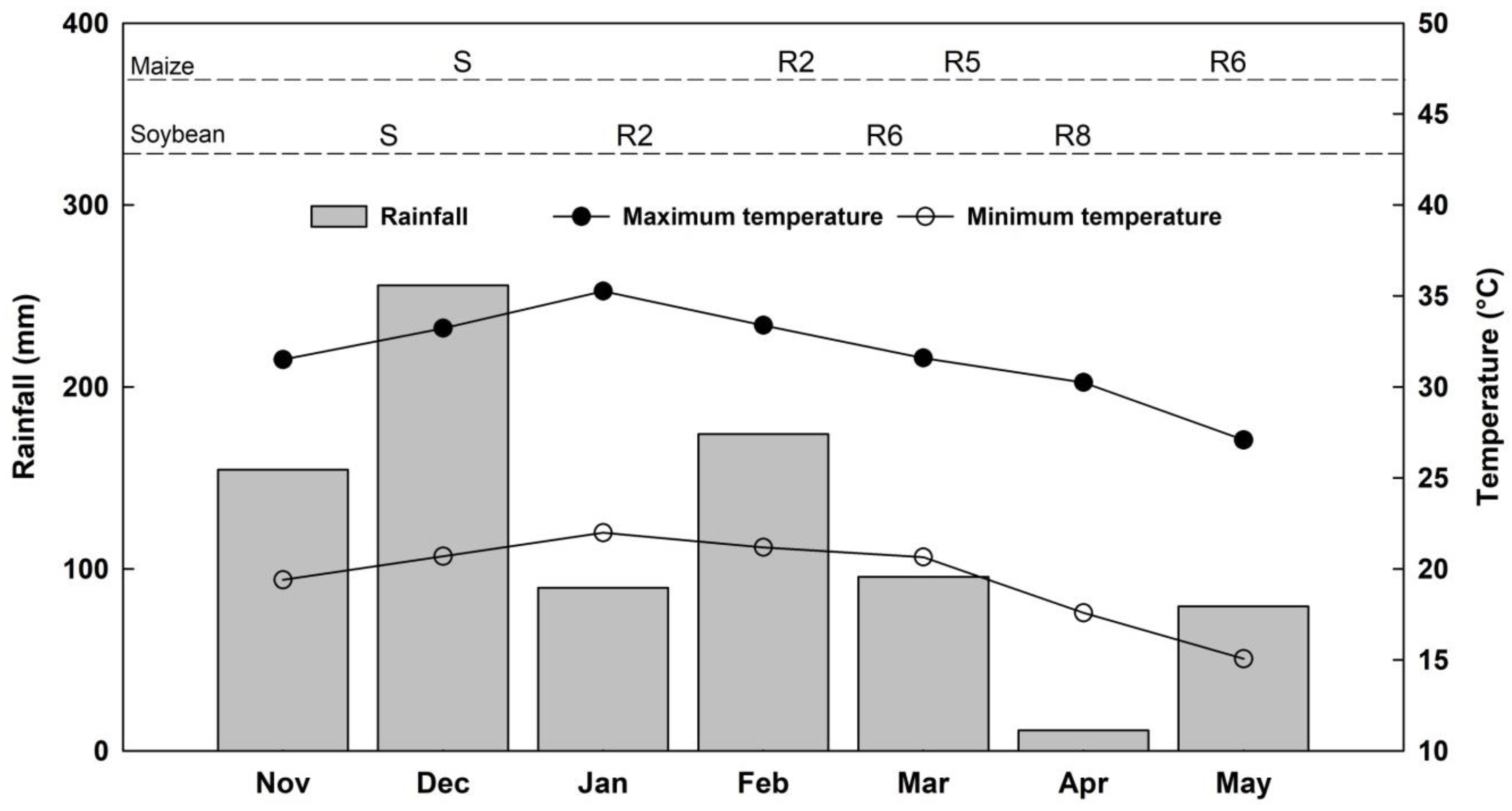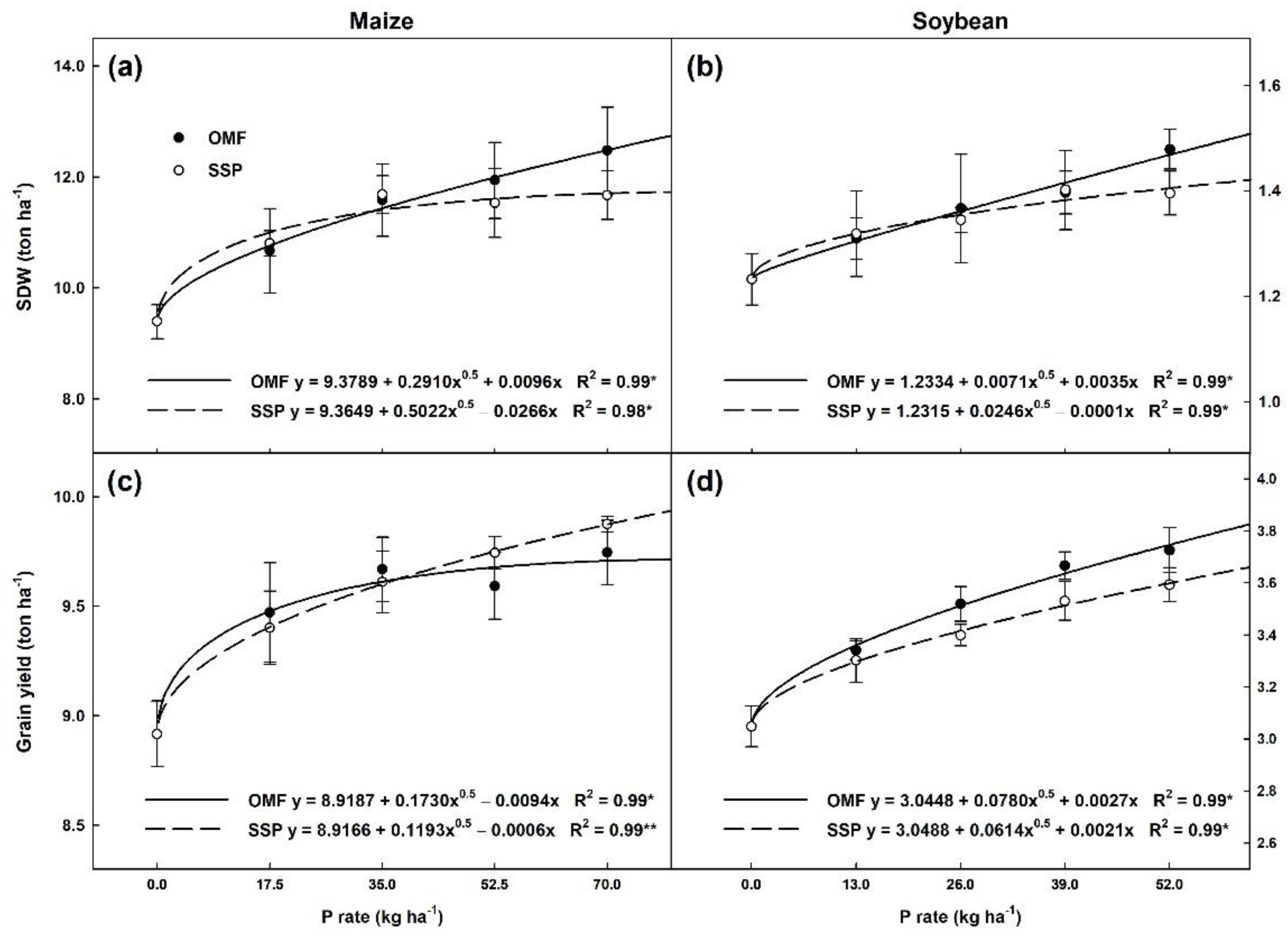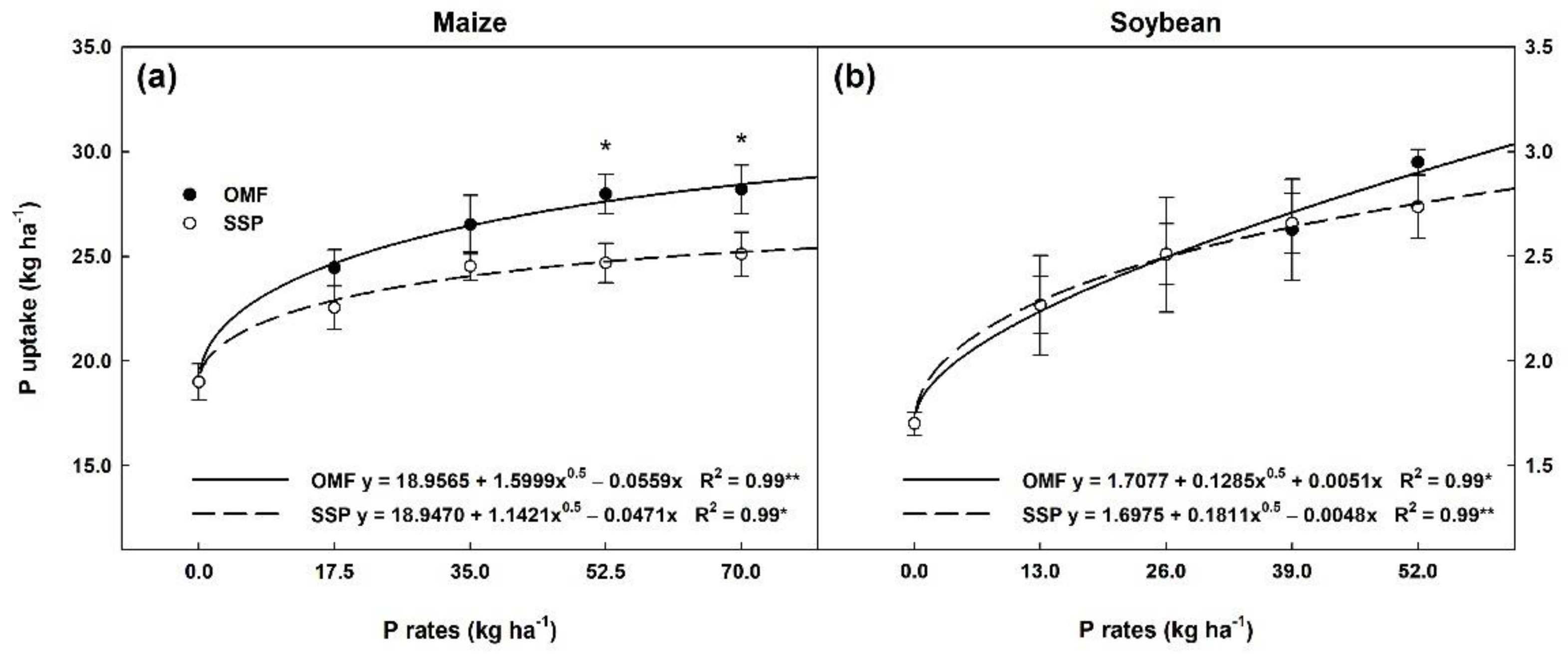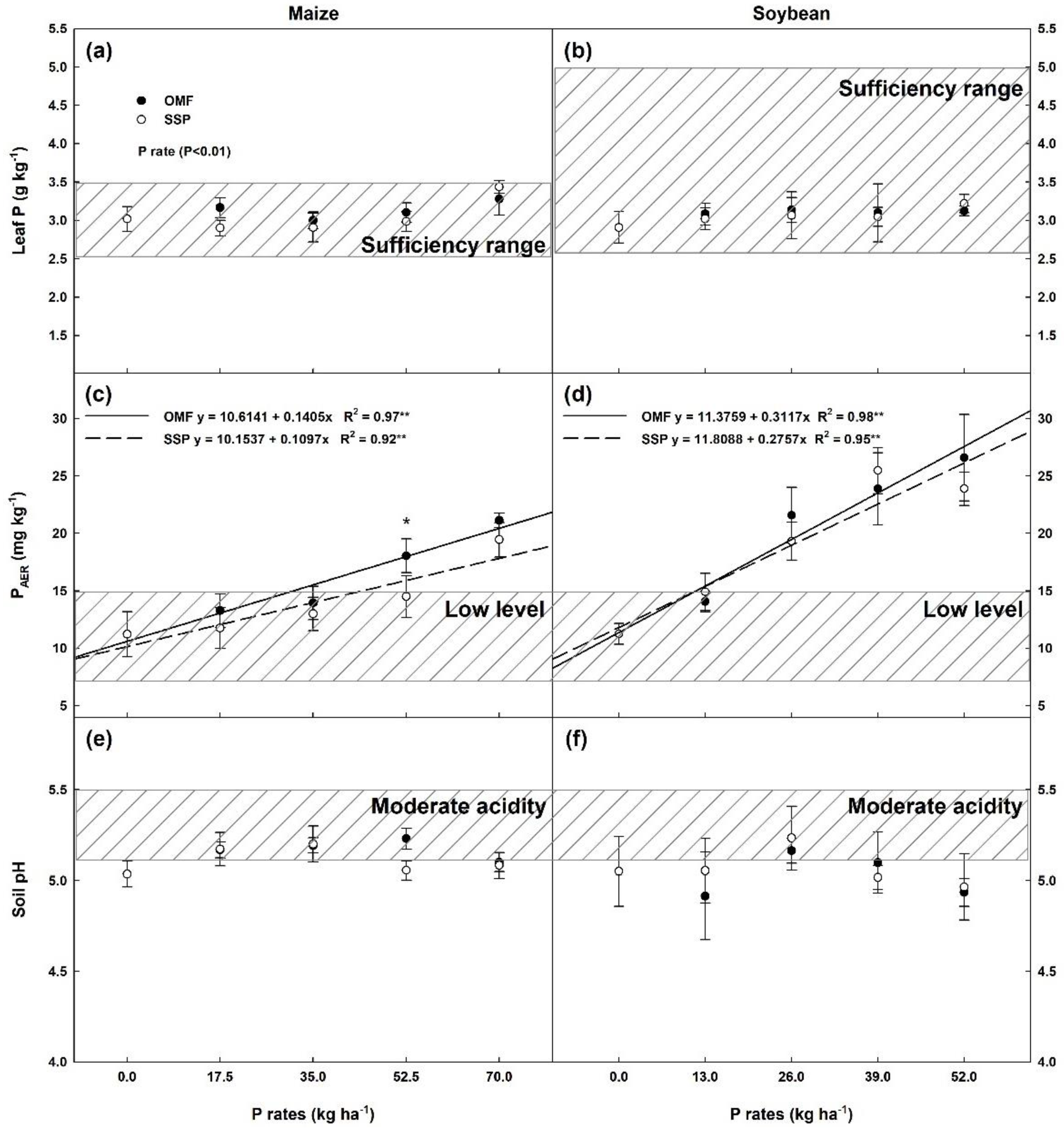A Poultry Litter-Derived Organomineral Phosphate Fertilizer Has Higher Agronomic Effectiveness Than Conventional Phosphate Fertilizer Applied to Field-Grown Maize and Soybean
Abstract
1. Introduction
2. Materials and Methods
2.1. Production of Granular Organomineral Phosphate Fertilizer
2.2. Site Description
2.3. Experimental Setup
2.4. Sampling and Chemical Analyses
2.5. Grain Yield Measurement and Calculations
2.6. Statistical Analyses
3. Results
3.1. Plant Growth and Grain Yield
3.2. Fertilizer-Phosphorus Uptake and Nutritional Status
3.3. Soil Test Phosphorus and Soil pH
3.4. Relative Agronomic Effectiveness
4. Discussion
4.1. Changes in Soil Phosphorus Availability
4.2. Crops Response to Phosphorus Fertilization
5. Conclusions
Supplementary Materials
Author Contributions
Funding
Institutional Review Board Statement
Informed Consent Statement
Data Availability Statement
Acknowledgments
Conflicts of Interest
References
- USDA. Livestock and Poultry: World Markets and Trade. Available online: https://downloads.usda.library.cornell.edu/usda-esmis/files/73666448x/9593vs24n/4m90fs46x/livestock_poultry.pdf (accessed on 11 August 2021).
- Sharpley, A.; Jarvie, H.P.; Buda, A.; May, L.; Spears, B.; Kleinman, P. Phosphorus legacy: Overcoming the effects of past management practices to mitigate future water quality impairment. J. Environ. Qual. 2013, 42, 1308–1326. [Google Scholar] [CrossRef] [PubMed]
- Schroeder, P.D.; Radcliffe, D.E.; Cabrera, M.L. Rainfall timing and poultry litter application rate effects on phosphorus loss in surface runoff. J. Environ. Qual. 2004, 33, 2201–2209. [Google Scholar] [CrossRef]
- Antille, D.L.; Sakrabani, R.; Godwin, R.J. Phosphorus release characteristics from biosolids-derived organomineral fertilizers. Commun. Soil Sci. Plant Anal. 2014, 45, 2565–2576. [Google Scholar] [CrossRef]
- Sakurada, R.; Batista, M.A.; Inoue, T.T.; Muniz, A.S.; Pagliari, P.H. Organomineral phosphate fertilizers: Agronomic efficiency and residual effect on initial corn development. Agron. J. 2016, 108, 2050–2059. [Google Scholar] [CrossRef]
- Bhunia, S.; Bhowmik, A.; Mallick, R.; Mukherjee, J. Agronomic efficiency of animal-derived organic fertilizers and their effects on biology and fertility of soil: A review. Agronomy 2021, 11, 823. [Google Scholar] [CrossRef]
- Florio, A.; Felici, B.; Migliore, M.; Dell’Abate, M.T.; Benedetti, A. Nitrogen losses, uptake and abundance of ammonia oxidizers in soil under mineral and organo-mineral fertilization regimes. J. Sci. Food Agric. 2016, 96, 2440–2450. [Google Scholar] [CrossRef] [PubMed]
- Cardoso, A.F.; Lana, R.M.Q.; Soares, W.; Peixoto, J.V.M.; Luz, J.M.Q. Performance of organomineral fertilizer in winter and rainy potato crop. Biosci. J. 2017, 33, 861–870. [Google Scholar]
- Frazão, J.J.; Benites, V.d.M.; Ribeiro, J.V.S.; Pierobon, V.M.; Lavres, J. Agronomic effectiveness of a granular poultry litter-derived organomineral phosphate fertilizer in tropical soils: Soil phosphorus fractionation and plant responses. Geoderma 2019, 337, 582–593. [Google Scholar] [CrossRef]
- Syers, J.K.; Johnston, A.E.; Curtin, D. Efficiency of Soil and Fertilizer Phosphorus Use; FAO: Rome, Italy, 2008; p. 108. [Google Scholar]
- Deeks, L.K.; Chaney, K.; Murray, C.; Sakrabani, R.; Gedara, S.; Le, M.S.; Tyrrel, S.; Pawlett, M.; Read, R.; Smith, G.H. A new sludge-derived organo-mineral fertilizer gives similar crop yields as conventional fertilizers. Agron. Sustain. Dev. 2013, 33, 539–549. [Google Scholar] [CrossRef]
- Morais, F.A.; Gatiboni, L.C. Phosphorus availability and microbial immobilization in a Nitisol with the application of mineral and organo-mineral fertilizers. An. Acad. Bras. Cienc. 2015, 87, 2289–2299. [Google Scholar] [CrossRef] [PubMed][Green Version]
- Corrêa, J.C.; Grohskopf, M.A.; Nicoloso, R.d.S.; Lourenço, K.S.; Martini, R. Organic, organomineral, and mineral fertilizers with urease and nitrification inhibitors for wheat and corn under no-tillage. Pesqui. Agropecu. Bras. 2016, 51, 916–924. [Google Scholar] [CrossRef][Green Version]
- Kominko, H.; Gorazda, K.; Wzorek, Z. The possibility of organo-mineral fertilizer production from sewage sludge. Waste Biomass Valorization 2017, 8, 1781–1791. [Google Scholar] [CrossRef]
- Mazeika, R.; Staugaitis, G.; Baltrusaitis, J. Engineered pelletized organo-mineral fertilizers (OMF) from poultry manure, diammonium phosphate and potassium chloride. ACS Sustain. Chem. Eng. 2016, 4, 2279–2285. [Google Scholar] [CrossRef]
- Oliveira, D.P.; Camargo, R.; Lemes, E.M.; Lana, R.M.Q.; Matos, A.L.A.; Magela, M.L.M. Organic matter sources in the composition of pelletized organomineral fertilizers used in sorghum crops. Afr. J. Agric. Res. 2017, 12, 2574–2581. [Google Scholar] [CrossRef][Green Version]
- Olivério, J.L.; Boscariol, F.C.; Mantelatto, P.E.; César, A.R.P.; Ciambelli, J.R.P.; Gurgel, M.N.A.; Souza, R.T.G. Integrated production of organomineral biofertiliser (BIOFOM®) using by-products from the sugar and ethanol agro-industry, associated with the cogeneration of energy. Sugar Tech 2011, 13, 17–22. [Google Scholar] [CrossRef]
- Rao, J.R.; Watabe, M.; Stewart, T.A.; Millar, B.C.; Moore, J.E. Pelleted organo-mineral fertilisers from composted pig slurry solids, animal wastes and spent mushroom compost for amenity grasslands. Waste Manag. 2007, 27, 1117–1128. [Google Scholar] [CrossRef]
- Mažeika, R.; Arbačiauskas, J.; Masevičienė, A.; Narutytė, I.; Šumskis, D.; Žičkienė, L.; Rainys, K.; Drapanauskaite, D.; Staugaitis, G.; Baltrusaitis, J. Nutrient dynamics and plant response in soil to organic chicken manure-based fertilizers. Waste Biomass Valorization 2021, 12, 371–382. [Google Scholar] [CrossRef]
- Teixeira, W.G.; Sousa, R.T.X.; Korndörfer, G.H. Response of sugar cane to doses of phosphorus provided by organomineral fertilizer (In Portuguese, with English abstract). Biosci. J. 2014, 30, 1729–1736. [Google Scholar]
- Antille, D.L.; Godwin, R.J.; Sakrabani, R.; Seneweera, S.; Tyrrel, S.F.; Johnston, A.E. Field-scale evaluation of biosolids-derived organomineral fertilizers applied to winter wheat in england. Agron. J. 2017, 109, 654–674. [Google Scholar] [CrossRef]
- BRASIL. Manual of Official Analytical Methods for Mineral, Organic and Organomineral Fertilizers and Correctives; MAPA/SDA: Brasília, Brazil, 2014; p. 220. (In Portuguese) [Google Scholar]
- Köppen, W.P. Grundriss der Klimakunde; Walter de Gruyter: Berlin, Germany, 1931; p. 390. [Google Scholar]
- Soil Survey Staff. Keys to Soil Taxonomy, 12th ed.; USDA-Natural Resources Conservation Service: Washington, DC, USA, 2014; p. 360. [Google Scholar]
- van Raij, B.; Andrade, J.C.; Cantarella, H.; Quaggio, J.A. Chemical Analysis for the Evaluation of Fertility of Tropical Soils; Agronomic Institute: Campinas, Brazil, 2001; p. 285. (In Portuguese) [Google Scholar]
- Bouyoucos, G.J. Estimation of the colloidal material in soils. Soil Sci. 1926, 64, 362–364. [Google Scholar] [CrossRef]
- van Raij, B.; Cantarella, H.; Quaggio, J.A.; Furlani, A.M.C. Fertilization and Liming Recommendation for the State of São Paulo, 2nd ed.; IAC: Campinas, Brazil, 1997; p. 285. (In Portuguese) [Google Scholar]
- Fehr, W.R.; Caviness, C.E.; Burmood, D.T.; Pennington, J.S. Stage of development descriptions for soybeans, Glycine max (L.) merrill. Crop Sci. 1971, 11, 929–931. [Google Scholar] [CrossRef]
- Abendroth, L.J.; Elmore, R.W.; Boyer, M.J.; Marlay, S.K. Corn Growth and Development; Iowa State University Extension: Ames, Iowa, 2011; p. 49. [Google Scholar]
- Malavolta, E.; Vitti, G.C.; Oliveira, S.A. Evaluation of the nuTritional Status of Plants, 2nd ed.; POTAFOS: Piracicaba, Brazil, 1997; p. 319. [Google Scholar]
- Chien, S.H.; Menon, R.G.; Billingham, K.S. Phosphorus availability from phosphate rock as enhanced by water-soluble phosphorus. Soil Sci. Soc. Am. J. 1996, 60, 1173–1177. [Google Scholar] [CrossRef]
- Mitscherlich, E.A. The law of the minimum and the law of diminishing soil productivity. Landwirtschqfliche Jahrbuecher 1909, 38, 537–552. (In German) [Google Scholar]
- Colwell, J.D. Estimating Fertilizer Requirements; CAB International: Wallingford, UK, 1994; p. 262. [Google Scholar]
- Gurgel, M.N.A.; Correa, S.T.R.; Dourado Neto, D.; Paula Júnior, D.R. Technology for sugarcane agroindustry waste reuse as granulated organomineral fertilizer. Engenharia Agrícola 2015, 35, 63–75. [Google Scholar] [CrossRef]
- Fernández, M.C.; Belinque, H.; Boem, F.H.G.; Rubio, G. Compared phosphorus efficiency in soybean, sunflower and maize. J. Plant Nutr. 2009, 32, 2027–2043. [Google Scholar] [CrossRef]
- Chien, S.H.; Sikora, F.J.; Gilkes, R.J.; McLaughlin, M.J. Comparing of the difference and balance methods to calculate percent recovery of fertilizer phosphorus applied to soils: A critical discussion. Nutr. Cycl. Agroecosyst. 2012, 92, 1–8. [Google Scholar] [CrossRef]
- Alcântara Neto, F.; Gravina, G.A.; Souza, N.O.S.; Bezerra, A.A.C. Adubação fosfatada na cultura da soja na microrregião do Alto Médio Gurguéia. Rev. Ciênc. Agron. 2010, 41, 266–271. [Google Scholar] [CrossRef]
- Oliveira Junior, A.; Prochnow, L.I.; Klepker, D. Soybean yield in response to application of phosphate rock associated with triple superphosphate. Scientia Agricola 2011, 68, 376–385. [Google Scholar] [CrossRef][Green Version]
- Sousa, D.M.G.; Lobato, E. Cerrado; Embrapa Informação Tecnológica: Brasília, Brazil, 2004; p. 416. [Google Scholar]
- Richardson, A.E.; Lynch, J.P.; Ryan, P.R.; Delhaize, E.; Smith, F.A.; Smith, S.E.; Harvey, P.R.; Ryan, M.H.; Veneklaas, E.J.; Lambers, H.; et al. Plant and microbial strategies to improve the phosphorus efficiency of agriculture. Plant Soil 2011, 349, 121–156. [Google Scholar] [CrossRef]
- Carvalhais, L.C.; Dennis, P.G.; Fedoseyenko, D.; Hajirezaei, M.-R.; Borriss, R.; von Wirén, N. Root exudation of sugars, amino acids, and organic acids by maize as affected by nitrogen, phosphorus, potassium, and iron deficiency. J. Plant Nutr. Soil Sci. 2011, 174, 3–11. [Google Scholar] [CrossRef]
- Wang, X.; Yan, X.; Liao, H. Genetic improvement for phosphorus efficiency in soybean: A radical approach. Ann. Bot. 2010, 106, 215–222. [Google Scholar] [CrossRef] [PubMed]
- Antille, D.L.; Sakrabani, R.; Godwin, R.J. Field-scale evaluation of biosolids-derived organomineral fertilisers applied to ryegrass (Lolium perenne L.) in England. Appl. Environ. Soil Sci. 2013, 2013, 9. [Google Scholar] [CrossRef]




| Fertilizers Composition | OMFm 1 | OMFs 2 | SSP 3 |
|---|---|---|---|
| pH (0.01 M CaCl2) | 5.9 | 5.9 | 2.7 |
| Organic carbon (g kg−1) | 245.3 | 233.4 | 0 |
| C:N ratio | 4.34 | 3.87 | - |
| Ptotal (g kg−1) | 104.44 | 90.78 | 81.92 |
| Pwater (g kg−1) | 55.08 | 58.09 | 43.64 |
| PNAC (g kg−1) 4 | 82.05 | 86.63 | 78.56 |
| Ntotal (g kg−1) | 56.5 | 60.3 | 0 |
| K2O (g kg−1) | 17.35 | 17.77 | 0 |
| B (mg kg−1) | 12 | 9 | 0 |
| Cu (mg kg−1) | 199 | 62 | 27 |
| Mn (mg kg−1) | 885 | 800 | 657 |
| Zn (mg kg−1) | 471 | 312 | 321 |
| Na (g kg−1) | 16.95 | 15.46 | 14.7 |
| Fe (mg kg−1) | 13.96 | 14.66 | 12.6 |
| pH | MPAC 1 | P | S | B | Cu | Fe | Mn | Zn | Ca | Mg | K | Al | CEC 2 | BS 3 | OM 4 | Clay | Sand | Silt |
|---|---|---|---|---|---|---|---|---|---|---|---|---|---|---|---|---|---|---|
| mg kg−1 | mmolc dm−3 | % | g dm−3 | g kg−1 | ||||||||||||||
| 5.0 | 1691.4 | 12 | 0.71 | 0.3 | 1.1 | 35 | 2.6 | 1.2 | 40 | 22 | 3.5 | 0 | 104 | 63 | 46 | 694 | 300 | 6 |
| Crop | P Rate (kg ha−1) | RAE-SDW (%) | RAE-P (%) | RAE-GY (%) | |||
|---|---|---|---|---|---|---|---|
| SSP | OMF | SSP | OMF | SSP | OMF | ||
| Maize | 17.5 | 100 a 1 | 91.7 b | 100 b | 154.59 a | 100 b | 114.81 a |
| 35 | 100 a | 96.65 b | 100 b | 137.15 a | 100 b | 108.48 a | |
| 52.5 | 100 b | 120.53 a | 100 b | 159.24 a | 100 a | 82.3 b | |
| 70 | 100 b | 136.54 a | 100 b | 151.62 a | 100 a | 86.67 b | |
| Mean | 100 b | 111.35 a | 100 b | 150.65 a | 100 | 98.24 | |
| P source | * 2 | * | ns 3 | ||||
| P rate | * | * | * | ||||
| Source x rate | * | * | * | ||||
| Soybean | 13 | 100 a | 90.64 b | 100 a | 65.81 b | 100 b | 115.53 a |
| 26 | 100 b | 120.33 a | 100 | 100.9 | 100 b | 134.53 a | |
| 39 | 100 | 98.47 | 100 | 98.09 | 100 b | 128.3 a | |
| 52 | 100 b | 151.94 a | 100 b | 121.78 a | 100 b | 124.69 a | |
| Mean | 100 b | 115.35 a | 100 | 96.65 | 100 b | 125.76 a | |
| P source | * | ns | * | ||||
| P rate | * | * | * | ||||
| Source x rate | * | * | * | ||||
Publisher’s Note: MDPI stays neutral with regard to jurisdictional claims in published maps and institutional affiliations. |
© 2021 by the authors. Licensee MDPI, Basel, Switzerland. This article is an open access article distributed under the terms and conditions of the Creative Commons Attribution (CC BY) license (https://creativecommons.org/licenses/by/4.0/).
Share and Cite
Frazão, J.J.; de Melo Benites, V.; Pierobon, V.M.; Ribeiro, J.V.S.; Lavres, J. A Poultry Litter-Derived Organomineral Phosphate Fertilizer Has Higher Agronomic Effectiveness Than Conventional Phosphate Fertilizer Applied to Field-Grown Maize and Soybean. Sustainability 2021, 13, 11635. https://doi.org/10.3390/su132111635
Frazão JJ, de Melo Benites V, Pierobon VM, Ribeiro JVS, Lavres J. A Poultry Litter-Derived Organomineral Phosphate Fertilizer Has Higher Agronomic Effectiveness Than Conventional Phosphate Fertilizer Applied to Field-Grown Maize and Soybean. Sustainability. 2021; 13(21):11635. https://doi.org/10.3390/su132111635
Chicago/Turabian StyleFrazão, Joaquim José, Vinicius de Melo Benites, Vitor Mateus Pierobon, João Victor Schiavon Ribeiro, and José Lavres. 2021. "A Poultry Litter-Derived Organomineral Phosphate Fertilizer Has Higher Agronomic Effectiveness Than Conventional Phosphate Fertilizer Applied to Field-Grown Maize and Soybean" Sustainability 13, no. 21: 11635. https://doi.org/10.3390/su132111635
APA StyleFrazão, J. J., de Melo Benites, V., Pierobon, V. M., Ribeiro, J. V. S., & Lavres, J. (2021). A Poultry Litter-Derived Organomineral Phosphate Fertilizer Has Higher Agronomic Effectiveness Than Conventional Phosphate Fertilizer Applied to Field-Grown Maize and Soybean. Sustainability, 13(21), 11635. https://doi.org/10.3390/su132111635








